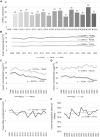Incidence of central retinal artery occlusion peaks in winter season
- PMID: 38318439
- PMCID: PMC10839045
- DOI: 10.3389/fneur.2024.1342491
Incidence of central retinal artery occlusion peaks in winter season
Abstract
Introduction: Stroke incidence exhibits seasonal trends, with the highest occurrences observed during winter. This study investigates the incidence of central retinal artery occlusion (CRAO), a stroke equivalent of the retina, and explores its monthly and seasonal variations, as well as potential associations with weather and ambient air pollutants.
Methods: A retrospective search of medical records spanning 15 years (January 2008-December 2022) was conducted at the University Eye Hospital Tübingen, Germany, focusing on diagnosed cases of CRAO. Incidences were evaluated on a monthly and seasonal basis (winter, spring, summer, fall). Weather data (temperature, precipitation, atmospheric pressure) and concentrations of ambient air pollutants [fine particulate matter (PM2.5), coarse particulate matter (PM10), nitrogen dioxide (NO2), and ozone (O3)], were analyzed for a potential association with CRAO incidence.
Results: Out of 432 patients diagnosed with CRAO between 2008 and 2022, significantly varying incidences were observed monthly (p = 0.025) and seasonally (p = 0.008). The highest rates were recorded in February and winter, with the lowest rates in June and summer. Concentrations of NO2, PM2.5 and lower ambient air temperature (average, minimum, maximum) showed significant correlations with CRAO incidence.
Discussion: This comprehensive 15-year analysis reveals a pronounced winter peak in CRAO incidence, with the lowest occurrences in summer. Potential associations between CRAO incidence and ambient air pollutants and temperature underscore the importance of considering seasonal trends and call for further investigations to elucidate contributing factors, potentially leading to targeted preventive strategies and public health interventions.
Keywords: air pollution; central retinal artery occlusion; incidence; public health; risk factors; seasonality; stroke.
Copyright © 2024 Gassel, Andris, Poli, Bartz-Schmidt, Dimopoulos and Wenzel.
Conflict of interest statement
The authors declare that the research was conducted in the absence of any commercial or financial relationships that could be construed as a potential conflict of interest.
Figures



References
LinkOut - more resources
Full Text Sources
Miscellaneous

